用2.5 kW连续co2激光对D9合金与AISI 316M不锈钢异种焊缝进行显微组织表征
IF 0.5
4区 工程技术
Q4 MATERIALS SCIENCE, MULTIDISCIPLINARY
引用次数: 6
摘要
在500兆瓦的印度原型快速增殖反应堆(PFBR)中,不同的焊缝、燃料包层管(D9合金)和由AISI 316M制成的端塞构成了燃料销的一部分。本研究旨在通过优化2.5 kW co2激光焊接参数,建立异种焊缝的抗裂纹组织。D9合金由于其较低的Cr当量/Ni当量比(接近1),首先凝固为初生奥氏体,这使得其焊缝特别容易凝固开裂。在本研究中,通过控制燃料包壳管和端塞的相对熔合度来调节熔合区的初级凝固模式。通过优化激光参数,将聚焦激光束向端塞侧偏移,使端塞材料对熔合区的贡献更大,获得了以初级铁氧体凝固模式为主的无缺陷焊缝。在激光终止处形成一个陨石坑和伴随的缺陷。本文章由计算机程序翻译,如有差异,请以英文原文为准。
Microstructural characterisation of a dissimilar weld of alloy D9 and AISI 316M stainless steel produced using a 2.5 kW CW CO 2 laser
The dissimilar weld, a fuel clad tube (D9 alloy) and an end plug made of AISI 316M forms a part of the fuel pin in the 500 MW Indian Prototype Fast Breeder Reactor (PFBR). The present study aimed at the development of a crack resistant microstructure of the dissimilar weld by optimisation of 2.5 kW CO 2 laser welding parameters. The D9 alloy, because of its low Cr eq /Ni eq ratio (close to 1), solidified first as primary austenite which makes its welds particularly susceptible to solidification cracking. In this study, the primary mode of solidification in the fusion zone was modulated by controlling the relative degree of fusion of the fuel clad tube and the end plug. A defect free weld with predominantly a primary ferrite mode of solidification was obtained by optimising laser parameters and displacing the focused laser beam towards the end plug side to achieve a greater contribution of end plug material to the fusion zone. The formation of a crater and associated defects at the termination site of lase...
求助全文
通过发布文献求助,成功后即可免费获取论文全文。
去求助
来源期刊

Lasers in Engineering
工程技术-材料科学:综合
CiteScore
1.00
自引率
20.00%
发文量
0
审稿时长
3.4 months
期刊介绍:
Lasers in Engineering publishes original (primary) research articles, reviews, short communications and letters on all aspects relating to the application of lasers in the many different branches of engineering and related disciplines.
The topics covered by Lasers in Engineering are the use of lasers: in sensors or measuring and for mapping devices; in electrocomponent fabrication; for materials processing; as integral parts of production assemblies; within the fields of biotechnology and bioengineering; in micro- and nanofabrication; as well as the materials and processing aspects of techniques such as cutting, drilling, marking, cladding, additive manufacturing (AM), alloying, welding and surface treatment and engineering.
Lasers in Engineering presents a balanced account of future developments, fundamental aspects and industrial innovations driven by the deployment of lasers. Modern technology has a vitally important role to play in meeting the increasingly stringent demands made on material and production systems. Lasers in Engineering provides a readily accessible medium for the rapid reporting of new knowledge, and technological and scientific advances in these areas.
 求助内容:
求助内容: 应助结果提醒方式:
应助结果提醒方式:


